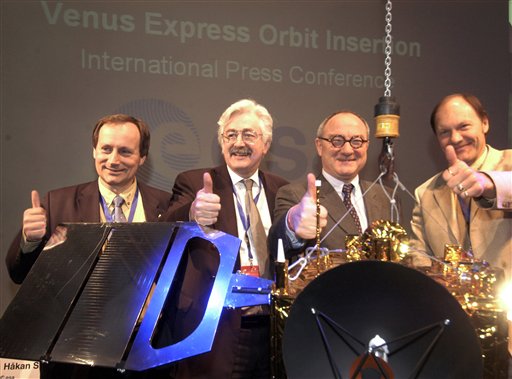 (AP) (AP) |
Officials at the European Space Agency's control center in Darmstadt cheered, clapped and embraced as a green line indicating a clear signal from the Venus Express appeared on their screens, a sign it had completed the maneuver inserting it into orbit.
"It's a fantastic mission for us. We've finally reached Venus," project manager Don McCoy said.
A short while later, scientists received the first data from the probe and praised the technical phase of the Venus mission _ ESA's fourth to a celestial body _ as a success.
Over the next several weeks, scientists will turn on the seven instruments on the probe and run them through tests. By June, they are expected to begin gathering information on how Venus, while similar to Earth in size and geological makeup, wound up with such a hot, dense atmosphere swathed in clouds of sulfuric acid.
"We want to learn about the mistakes of Venus for the sake of the Earth," ESA Scientific Director David Southwood said.
An initial image of Venus' south pole is expected Thursday.
To start Tuesday's maneuver, controllers fired the probe's rocket engine to slow it down so Venus' gravity could pull it into orbit. It then disappeared behind Venus for roughly 10 minutes, leaving controllers without contact as it swung around the back of the planet. It re-emerged on schedule _ an accomplishment credited to lessons learned from the Mars Express, on which Venus Express was modeled.
Venus Express was launched Nov. 9 atop a Russian booster rocket from the Baikonur Cosmodrome in Kazakhstan.
"We've put together a second planetary mission in as short a time as possible," McCoy said. "We've put two satellites around two planets. It's incredible what we've accomplished."
The Mars Express, which was launched in 2003, is still circling that planet.
In addition to the Mars and Venus missions, ESA also operates SMART-1 around the moon and is working with NASA on the Cassini orbiter around Saturn. The Rosetta probe also is en route to land on a comet, a journey expected to last another nine years.
The seven instruments aboard the $260-million Venus Express craft include spectrometers to measure temperature and analyze the atmosphere and a special camera to concentrate on activity among Venus' many volcanoes.
Scientists hope the data received will help answer questions about why Venus wound up with an atmosphere almost 90 times denser than Earth's. Of key importance will be studying Venus' strong greenhouse effect _ the way carbon dioxide traps the sun's heat _ and the permanent hurricane force winds that constantly circle it high in the planet's atmosphere.
Venus is the nearest planet to Earth, and the two share similar mass and density, both with inner cores of rock believed to have been formed at roughly the same time. But Venus' atmosphere is made up almost entirely of carbon dioxide and has very little water vapor.
Thanks to runaway warming from its greenhouse effect, Venus has the hottest surface of all the planets _ around 864 degrees. The aluminum-frame probe is coated with a metallic polymer skin to protect it from heat.
"Venus is quite close to Earth, yet so radically different," McCoy said. "Why is that?"
ESA plans to keep the probe active for 500 days, with the possibility of extending its life by 500 more.
The last mission to Venus was NASA'S Magellan probe, launched in 1989. It completed more than 15,000 orbits around the planet between 1990 and 1994. Using radar, Magellan was able to map almost all of Venus, revealing towering volcanoes, gigantic rifts and sharp-edged craters.